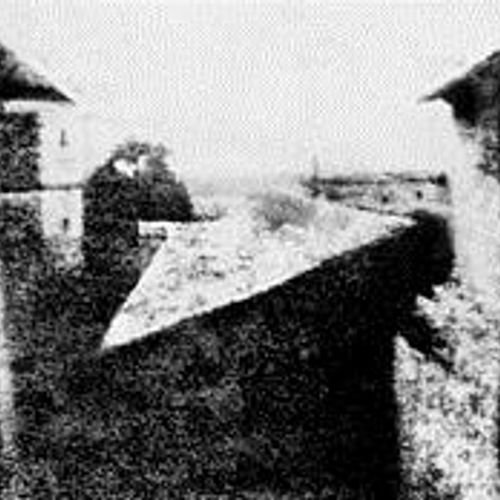The history of how the photos are presented for informational purposes only. This information allows to evaluate the technologies used in a certain time period, and hence to assess the capabilities of photographers and retouchers, defects shooting, etc.
A complete chronology of the main events of the history of photography and cinematography, as well as major inventions and ideas have influenced the development of photography, can be found in the sources listed at the end of the article. We here consider only the main, relevant to our subject.
In ancient times people noticed that from the sun rays darken the human skin and certain types of stones and substances . This can be called the first beginnings of understanding of the chemical nature of taking a photo. Optical background of the photo starts in the V century BC The first camera obscura could be called a "room, part of which is illuminated by the sun."
Already in the tenth century Arab mathematician and scientist Alhazen from Basra, who wrote about the basic principles of optics and studied the behavior of light, used the camera obscura for observing eclipses of the sun.
The first steps towards modern photography did in 1727g. physician and Professor of anatomy Johann Heinrich Schulze. He's one of the first discovered and proved experimentally the light sensitivity of silver nitrate. Almost fifty years later, in 1770, the Swedish chemist Carl Wilhelm Scheele made the first experiments with silver chloride, and opened its sensitivity. He also revealed that with ammonia the resulting pictures can be made indelible. Thus, he invented the process of developing/fixing. However, only in 1798. Brothers Claude and Joseph Nicephore Niepce conducted the first experiments on the chemical fixation of images obtained using a pinhole Camera.
1816 Joseph Nicephore Niepce got the first paper photographs using a camera of his own design, photographing from the window of your office. In 1822 he made the first fixed image, but it has not survived to our days. So the first photograph is considered to be the "window view" obtained by Niepce in 1826 using a pinhole camera on a tin plate covered with a thin layer of asphalt. The exposition lasted eight hours in bright sunlight.
From this point is over the background of pictures and began its history and rapid development.
Almost ten years later, in 1835, Fox Talbot received a negative image on paper (one square inch) that was placed in the photographic camera. And already in 1840 in the United States Alexander Walcot opened the first portrait Studio.
Errol Morris (Errol Morris) said: "Probably, it took less than ten minutes from the invention of photography to the moment when people realized that using photos can be deceiving."
In 1841, the photographer and engraver on copper, Isenring first retouched image obtained by dagerotipii. And in 1857 was created one of the first and most famous photo montages. It is considered to be the work of Oscar Gustave Rejlander "Two ways of life".
Further development of the methods of photography went very fast. They laid the Foundation for the birth of cinema. Improved camera and photography began to acquire a mass.
1878. Edward Muybridge did high-speed photographic demonstration of a moving horse, completely detached from the ground at the trot, on the basis of a mechanical device alternating descent gates cameras.
1888. Massively sold the first easy to use box camera Kodak No. 1.
1887. Gabriel Lippmann invented the "method of photographic color reproduction based on interference".
1891. Thomas Edison patented the peep show to showcase moving images.
So, after only 150 LEL, in 1895, August and Louis Lumiere patented the "cinématographe", and in 1898, Kodak introduced the first folding pocket camera.
The twentieth century is considered the beginning of the digital era for photography and video.
In 1963, Ivan Sutherland introduced the world's first graphical editor and CAD system Sketchpad. He became part of the thesis of Sutherland's doctoral degree at the Massachusetts Institute of technology and, unfortunately, so she stayed. However, he strongly influenced the development of professional design systems like Auto CAD. To create drawings use a "light pen" (the ancestor of our modern stylus for your tablet).So clearly it demonstrated that computer graphics can be widely used by engineers and artists.
In 1976, Fairchild released the first commercial electronic camera MV-101, which was used on the conveyor Procter&Gamble for quality control of products. It was already the first fully digital camera, transmit the image to the minicomputer, DEC PDP-8/E with a special parallel interface.
In 1980 Sony introduced the first color camera based on a CCD-matrix (before all the cameras were black and white).
In 1984, there is a mass image editor MacPaint, and in 1985 published In A Vision (Micrografx). Peravia same version of Adobe Photoshop only in 1987.
By 1990 there was already a completely digital commercial camera, the Logitech FotoMan FM-1. It was black and white and had a resolution of 376×240 pixels, and 1 MB internal memory stores 32 images, built-in flash and the ability to connect the camera to the computer.
These are the basic stages of the history of photography. With the advent of each new discovery, this direction began to develop rapidly, the technology to improve, giving rise to a new stage.
Translated by «Yandex.Translator»
Oscar Gustav Rejlander (Oscar Gustav Rejlander). "Two ways of life". 1857
Translated by «Yandex.Translator»
Log in or register to post comments


